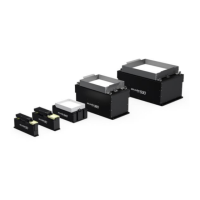25/46
6.1. Actions
Four types of actions exist. The actions either concern the hopper/outputs, the platform or
none of the latter.
6.1.1. Hopper/output
Any of the 26 hopper vibrations/output activations (A – Z) of a vibration set can be selected in
order to feed parts onto the platform. By choosing between the three duration modes ‘Fixed’,
‘Quantity adjusted’ and ‘Vibration ratio’, the user can adjust the vibration duration of the
hopper in order to obtain different types of behaviour (see 6.2 Duration modes on page 26).
6.1.2. Platform
Any of the 26 platform vibrations (A – Z) of a vibration set can be selected in order to obtain
the desired part movement on the platform. By choosing between the three duration modes
‘Fixed’, ‘Quantity adjusted’ and ‘Vibration ratio’, the user can adjust the vibration duration of
the platform in order to obtain different types of behaviour (see 6.2 Duration modes on page
26).
Other than the platform vibrations, the user may select the smart vibration ‘Centring' which
centres parts no matter where they are located.
6.1.3. Wait
This action corresponds to a fixed waiting time given in ms. It is principally used between the
end of a vibration and before image acquisition in order to wait for the parts to stabilise on the
platform (i.e. to stop rolling/moving).
6.1.4. None
‘None’ corresponds to an empty action (non-programmed). This option is used for sequences
that do not require all of the seven available actions.

